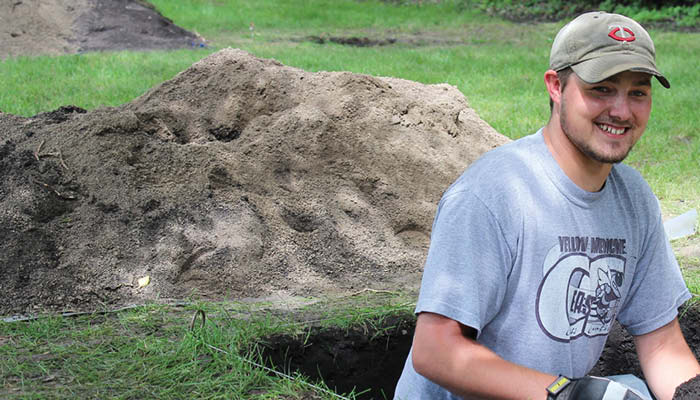Archeological students from Minnesota State University Moorhead have spent the last two weeks working to uncover artifacts from the carriage house that was once part of the Comstock Property in Moorhead. Most people are likely aware of the Comstock House on 8th Street. The house is one of the Minnesota Historical Society’s 26 historical sites and museums. What people may not know, however, is that the house was once part of a city block sized property that included an ice house, tool room, food storage room, and carriage house for three horses and three carriages. The MSUM students are attempting to discover remains from the carriage house, which was dismantled in the early 1900’s.
Who Are the Comstocks?
The Comstock name is well-known in Moorhead. In addition to the Comstock House, the name can be found on other buildings, such as the Comstock Memorial Union on the MSUM campus. Solomon G. Comstock was a successful lawyer, businessman, and politician. He served four terms as a State Representative, one as a State Senator, and one as a member of the U.S. House of Representatives. More importantly, he assisted in the prosperous growth of the city of Moorhead. He helped form the First National Bank of Moorhead in 1881, helped build the Bishop Whipple School in 1882 (which later became Concordia College), and donated land and sponsored a bill in the MN State Legislature to establish the Moorhead Normal School (which later became MSUM). His fingerprints can be seen all over the city.
Solomon wasn’t the only successful member of the Comstock family. His wife Sarah was also active within the community. In 1893, she secured a donation from Andrew Carnegie to build a town library in 1905-06. The Comstock children also made their mark on the world. Eldest daughter Ada Louise earned a Master’s Degree in 1899 and went on to become the first dean of women at the University of Minnesota in 1901, the academic dean at Smith College from 1912-1922, and the first full-time president of Radcliffe College in Cambridge, Massachusetts. Younger sister Jessie May became a school teacher in Minneapolis before returning to Moorhead to care for her aging parents. Finally, youngest child George Madison graduated from Harvard, served in World War I, and then returned to Moorhead where he became a prominent businessman. The entire Comstock family was not only successful; they were committed to the city of Moorhead and its future. It is very fitting that their family name is so revered.
The Comstock House:
The eleven-room Comstock house was built by Solomon in 1883. The Victorian house combined Queen Anne and Eastlake architectural styles into what was surely one of the finest houses in the area. The house was donated to the Minnesota Historical Society in 1965 and is currently run by the City of Moorhead. The house was restored to its original condition in 1974.
MSUM Anthropology and Earth Science Program:
The Anthropology and Earth Science Department at MSUM consists of the following programs of study: Archeology, Anthropology, Geo-archeology, Geographical Sciences, and Geology. The students currently participating in the Comstock dig are part of a 5-week archeological field school under the supervision of director Jayme Job. “The students are learning hands-on research skills,” Job explained. Those skills include learning how to dig, how to use a GPS, how to excavate and process artifacts, and how to produce and process archeological data.
The focus of the dig is the area thought to be the site of the old carriage house. This project began last year as part of a geo-archeology field school taught by program Chair and Professor Rinita Dalan. Those students used geo-physical methods such as electrical resistivity, magnetic susceptibility, and electromagnetic conductivity to map out features of the original property. Students were able to determine the location of the carriage house, discover a road leading to the property from 8th street, and map out property structures such as pipes and tress. “The students were very successful,” said Dalan.
The current dig is part of an extensive project that many students have been involved in for several semesters. In addition to the last summer’s geo-archeology and this summer’s archeological field schools, the students have also studied the history of the Comstock property and created a brochure that is currently being used at the house. The obvious goal of the project is educating the students with real-life experience. A side goal, however, is to educate the public as well. “We would love for the public to learn more about the Comstock House,” Job said.
The Comstock House is one of Moorhead’s true treasures. Learning more about its history is beneficial not only to the students involved, but also to the residents of the city. History is lost if it is not preserved. Society needs to understand and appreciate where they came from and who or what is responsible for the world they live in. This information needs to be preserved for future generations as well. Thanks to the students at MSUM, the rich and important history of the Comstock House will not be lost or forgotten.
More information about the Comstock House can be obtained at. http://sites.mnhs.org/historic-sites/comstock-house.
More information about the Anthropology and Earth Science program at MSUM can be found at http://www.mnstate.edu/anthearth/majorsandminors.com.



